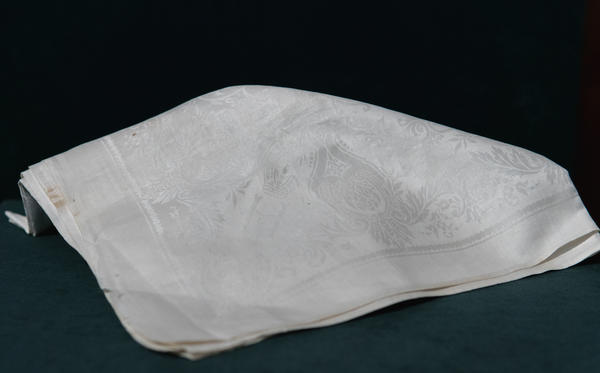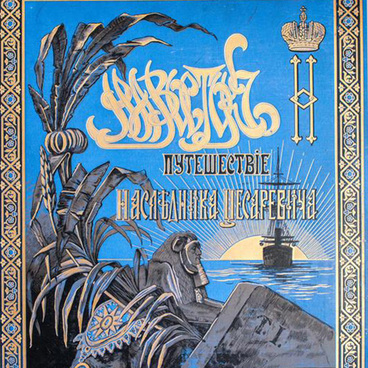When Nicholas II and his family set off to Tobolsk exile, most of dishes and kitchen wares were sent there from Tsarskoe Selo. Among them there were tablecloths and table napkins. One of them is now stored in Tobolsk Historical and Architectural Museum — Reserve.
Entire surface of napkin is adorned by tracery that was manually woven at the factory. In the middle of background there is the Russian Empire emblem and in corners — the monogram of Nicholas II: the crown, under which there is letter N and Latin number II. These elements show that table linen was produced by special order for the family of the last Russian Emperor. The rest of the pattern was made in the form of interwoven stems and leaves.
The rectangular napkin was manufactured from poplin — dense and soft fabric, which appeared as far back as the 14th century at the court of the Pope of Rome. This is how its name descended from: in some foreign languages, this word meant papal.
Poplin were woven from threads of different thicknesses: the base was softer and thinner, the weft was dense. Such kind of weave formed a small scar on the surface of canvas. In Russia, such fabric appeared only in the 18th century, but became popular quickly. Ladies' gowns, men’s shirts, bed-clothes, tablecloths were made of it. This fabric most often consisted from silk fibers. However, the imperial family napkins were made from thin flax.
Colonel Evgeny Kobylinsky donated the table napkin, which is kept in the Museum of the Family of Emperor Nicholas II, to Tobolsk Historical and Architectural Museum — Reserve. Since March 1917, he was serving the head of the Tsar’s security. There, he made friends with the Romanovs and earned a trust of Nicholas II. Tsarevich Alexei’s tutor, Pierre Gilliard, reminisced about Kobylinsky as the “best friend” of the disgraced emperor.
After the Tsar’s family departure to Ekaterinburg, Evgeny Kobylinsky remained in Tobolsk. Provincial commissar Vasily Pignatti, who served as the custodian of the Tobolsk Museum at that time, helped him donate objects from the collection that belonged to the Imperial Family.
Entire surface of napkin is adorned by tracery that was manually woven at the factory. In the middle of background there is the Russian Empire emblem and in corners — the monogram of Nicholas II: the crown, under which there is letter N and Latin number II. These elements show that table linen was produced by special order for the family of the last Russian Emperor. The rest of the pattern was made in the form of interwoven stems and leaves.
The rectangular napkin was manufactured from poplin — dense and soft fabric, which appeared as far back as the 14th century at the court of the Pope of Rome. This is how its name descended from: in some foreign languages, this word meant papal.
Poplin were woven from threads of different thicknesses: the base was softer and thinner, the weft was dense. Such kind of weave formed a small scar on the surface of canvas. In Russia, such fabric appeared only in the 18th century, but became popular quickly. Ladies' gowns, men’s shirts, bed-clothes, tablecloths were made of it. This fabric most often consisted from silk fibers. However, the imperial family napkins were made from thin flax.
Colonel Evgeny Kobylinsky donated the table napkin, which is kept in the Museum of the Family of Emperor Nicholas II, to Tobolsk Historical and Architectural Museum — Reserve. Since March 1917, he was serving the head of the Tsar’s security. There, he made friends with the Romanovs and earned a trust of Nicholas II. Tsarevich Alexei’s tutor, Pierre Gilliard, reminisced about Kobylinsky as the “best friend” of the disgraced emperor.
After the Tsar’s family departure to Ekaterinburg, Evgeny Kobylinsky remained in Tobolsk. Provincial commissar Vasily Pignatti, who served as the custodian of the Tobolsk Museum at that time, helped him donate objects from the collection that belonged to the Imperial Family.



